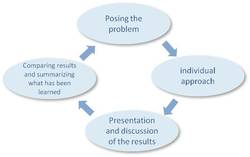Autonomous work in everyday teaching situations
Structure of a lesson
- Posing the problem: Usually done by the teacher; but by frequent repetition of the cycle above it may well be possible that the students themselves suggest a new way of posing the problem from their previously acquired knowledge or the problem may be posed in cooperation. The formulation of the problem should not contain any ideas about how to solve it.
- Individual approach: The students work individually or in small groups over a comparatively long period of time. The teacher acts as an observer and adviser (support to self-help) . During this time the teacher can already choose from various ideas and approaches and nominate the candidates for the presentation.
- Presenting results: Selected students present their propositions. These presentations are then compared, discussed and evaluated. The teacher should interfere as little as possible and only act as a guide if necessary. Even erroneous propositions should be discussed. Ideas which lead far away from the original approach are particularly valuable.
- Summarizing what students have learned: Only now the teacher takes over and shortly summarizes all the results. Perhaps he has to add a few indispensable items, new terms and formal aspects could be introduced here.
More about this concept can be found in P. Baptist, V. Ulm, Anregungen zu individuellen Lernwegen, in MU Der Mathematikunterricht, Jg. 51, Heft 2/3, Juni 2005
This concept closely follows Peter Gallin, Urs Ruf, Dialogischer Unterricht.

